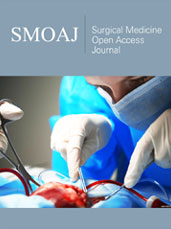- Submissions

Abstract
Surgical Medicine Open Access Journal
Surgical Implantation of Autologous Dopamine Neuron Progenitor Cells (DANPCs) Into the Putamen of Patients with Parkinson’s Disease
-
Open or CloseMichael AS Guth*
Risk Management Consulting, USA
*Corresponding author:Michael AS Guth, Risk Management Consulting, Oak Ridge, Tennessee, USA
Submission:November 20, 2024;Published: December 16, 2024

ISSN : 2578-0379Volume6 Issue1
Objective: To describe a new clinical trial testing the safety and efficacy of implanting autologous
Dopamine Neuron Progenitor Cells (DANPCs) into the brain of patients with Parkinson’s Disease (PD) as
regenerative therapy for dopamine deficiency caused by PD.
Background: PD affects the putamen through multiple mechanisms. Dopamine depletion occurs as PD
causes a gradual loss of dopaminergic neurons in the substantia nigra pars compacta, leading to reduced
dopamine levels in the putamen. This dopamine depletion then contributes to motor dysfunction.
Additionally, the putamen can undergo atrophy, which is associated with both motor symptoms and
cognitive impairment. PD can be managed with medications for a limited period, but PD has no cure. The
standard treatments for PD have remained unchanged for several decades and do not slow the disease
progression. Cell Replacement Therapy (CRT) presents an alternative approach that has the potential to
restore striatal dopaminergic input and ameliorate debilitating motor symptoms in PD.
Methods: The ASPIRO clinical trial (Currently in Phase 1 and 2a) purports to be the first multi-center
trial for an autologous neuron replacement therapy for Parkinson’s disease. The clinical trial tests an
experimental biologic product derived from autologous skin cells converted to induced pluripotent stem
cells. The stem cells are differentiated into Dopamine Neuron Progenitor Cells (DANPCs). Dose escalation
will be achieved by bilateral injection of these DANPCs into the putamen. After drilling a burr hole in the
skull, the neurosurgeon inserts a small catheter with the help of a smart frame through the parenchymal
tissue to the putamen.
Data sources & results: The ASPIRO Trial is currently enrolling patients by invitation, but no results are
yet available. The first trial patient has been successfully dosed with his autologous DANPCs.
Discussion: Case studies involving male patients with fetal nigral transplants in the striatum have
demonstrated that the transplanted dopamine neurons can survive and reestablish connections in
the striatum for a minimum of 10 years, even as the disease continues to progress and destroy the
patients’ native dopamine neurons. Intraparenchymal injections are more surgically invasive than other
administration routes. Still, they have some advantages: the dose of the vector can be lower when using
intraparenchymal injections, and preexisting neutralizing antibodies have little effect on the transduction
efficacy of biologics injected directly into the putamen. A prominent factor contributing to acute cell death
during injection is the influence of mechanical forces on cells; specifically, the extensional force arising
from differing velocities distorts cell length.
Keywords:Parkinson’s disease; Putamen; Caudate nucleus; Induced pluripotent stem cells; Sporadic Parkinson’s; Substantia nigra pars compacta; MRI-guided neurosurgery; Cell replacement therapy; Neurosurgical delivery
Get access to the full text of this article a Creative Commons Attribution 4.0 International License. Based on a work at www.crimsonpublishers.com.
Best viewed in
a Creative Commons Attribution 4.0 International License. Based on a work at www.crimsonpublishers.com.
Best viewed in 







.jpg)






























 Editorial Board Registrations
Editorial Board Registrations Submit your Article
Submit your Article Refer a Friend
Refer a Friend Advertise With Us
Advertise With Us
.jpg)






.jpg)














.bmp)
.jpg)
.png)
.jpg)










.jpg)






.png)

.png)



.png)






